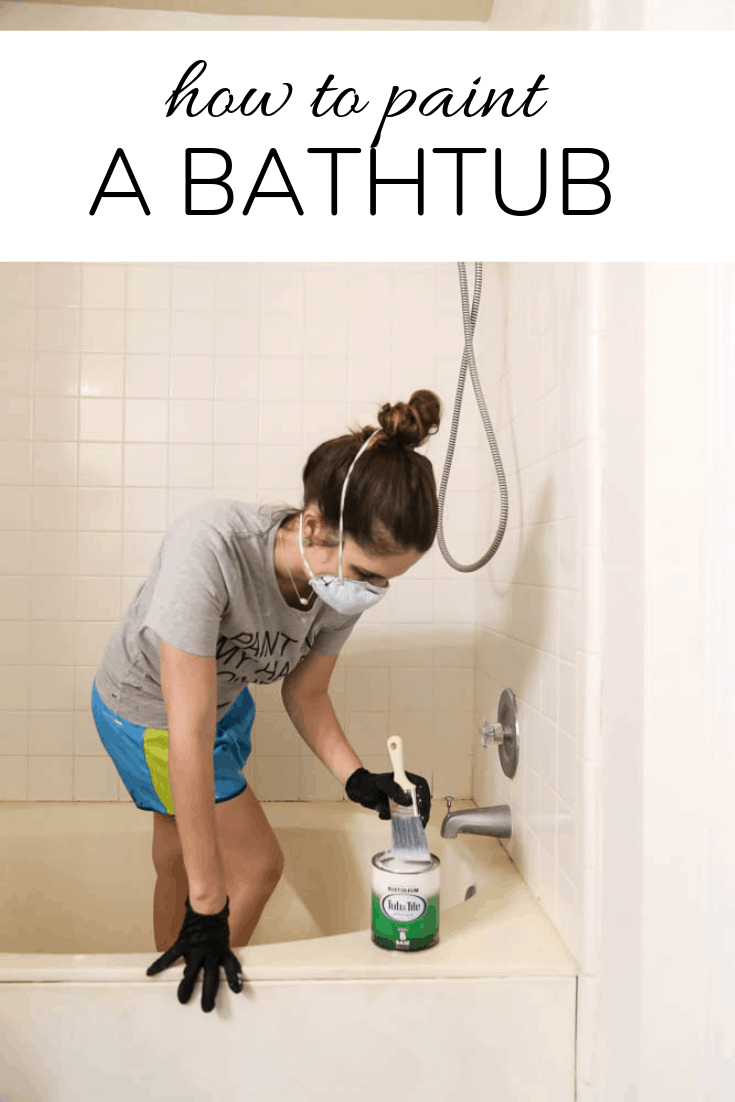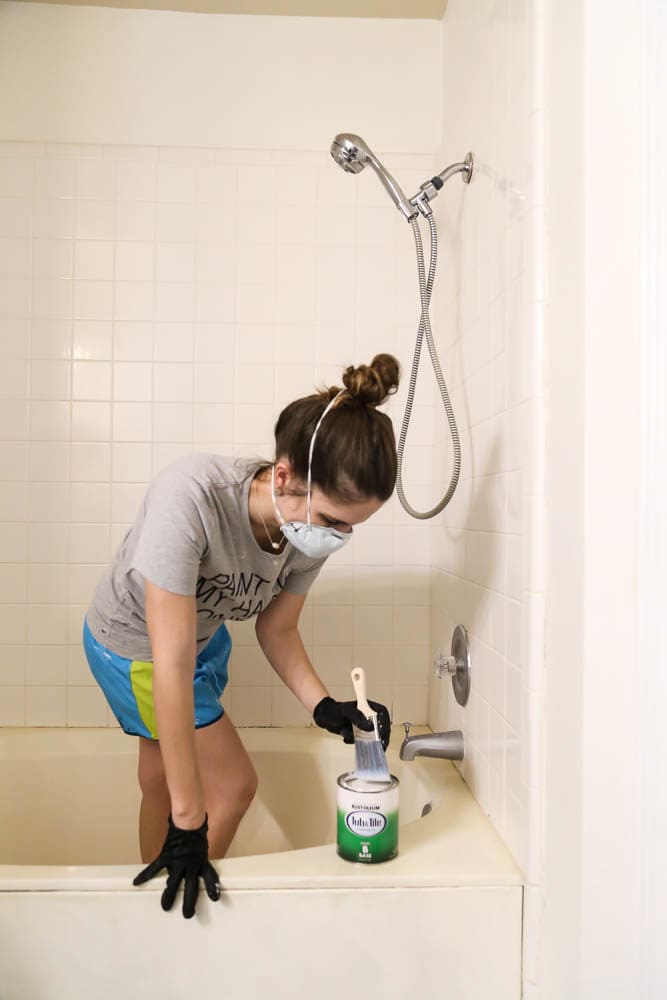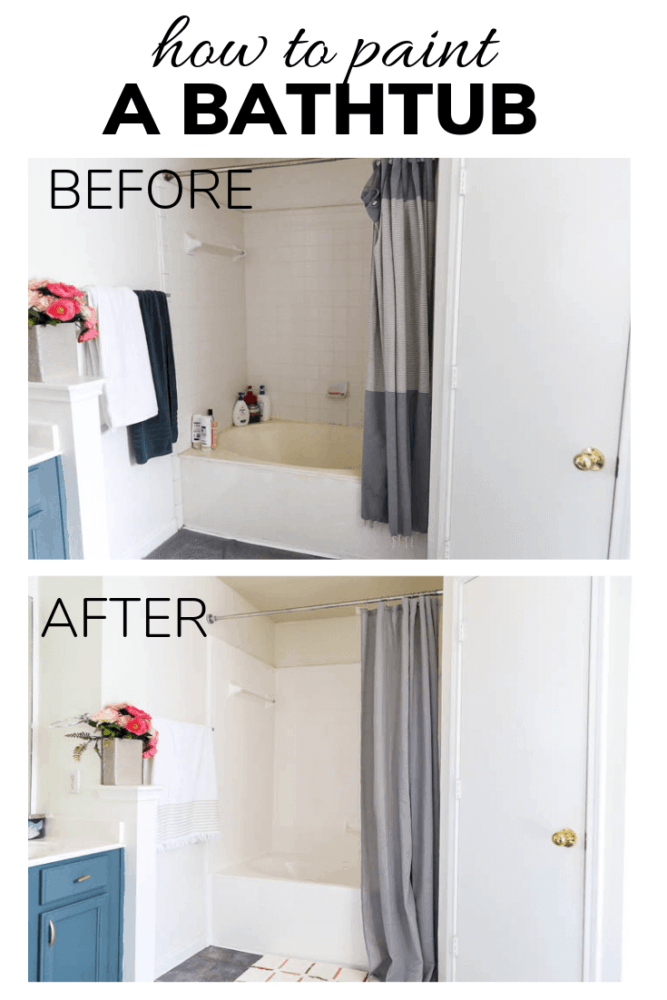How To Paint My Tub

Have an ugly bathtub or shower surround? What if I told you you can paint your bathtub to make it look fresh, clean, and beautiful?! Read on to learn how to paint a bathtub!
Note: This post was originally published in February of 2019. I'm updating and republishing it in an effort to give some new life to old projects!

This post contains affiliate links. Click here to read my full disclosure policy.
Ugly bathtubs are the worst.
When my husband and I lived in our first apartment together, we had a mustard yellow bathtub and surround – and not in a cute, vintage way. It was so bad, and I cringed a little every time I had to use it!
In this home, our bathtub wasn't quite as horrifying but it was pretty darn ugly. The tub was a marbled off-white that always felt dirty, and the tiles were a different color of off-white that had seen better years.
I knew there had to be an affordable way to fix it, so I did some research and decided to try out Rust-Oleum's Tub & Tile Refinishing Kit. It brightened the entire room up significantly, and now the bathtub actually feels clean when I clean it.
What a novel concept!
This bathroom also saw a lot of other changes – all very affordably. Read to the end of the post for all of the details on how we totally transformed this bathroom using (almost) nothing but paint!
Refinishing your bathtub is one of those projects that seems incredibly intimidating if you aren't super comfortable with DIY. I want to take a moment to assure you that it's not that hard. As long as you follow the directions and take your time, you will end up with a gorgeous result that will fool everyone into thinking your tub has always been bright and shiny.
My favorite thing about this project is how absolutely affordable it is to completely change the look of your bathtub. The kit only costs about $25 and covers a standard-sized tub. We have a garden tub (and I was applying the epoxy to the tile as well), so I ended up using three kits. I could have easily gotten away with just two if I had waited a little longer between the first and second coat (I had to do three coats on the bathtub, which is why I needed the third kit), but $75 for a project this transformative is so good it's silly!

This project took me about three days to complete. If you don't have a five-year-old and a teething baby in your house, you could probably knock it out in just one. I'll detail the timeline below (and why I needed a third coat, so you can avoid my mistakes).
The kit requires that you allow it to dry for a full three days before you shower in it again, so be aware of that before you start this project! If you don't have a secondary bathroom, plan on borrowing a friend's shower or heading to the gym to clean up.
Or, you know, just embrace the stink. It'll make your first shower in your newly-refinished tub that much sweeter.
Okay, let's do this. Here's a reminder of what our tub looked like BEFORE I got started.


How to Paint a Bathtub Using Rust-Oleum's Tub & Tile Refinishing Kit
Note: In this post, I detail the steps for usingRust-Oleum's Tub and Tile Refinishing Kit. Please feel free to use this as a reference, but please do NOT attempt this project without fully reading the instructions that come with the kit!
Step One: Clean Tub & Remove Caulk

The directions state that you should clean the tub before removing the caulk, but I knew I was going to make a giant mess removing the caulk anyways, so I decided to tackle that first.
To remove the caulk, I just used a sharp razor blade and ran it along either side of the caulk, then peeled it up.
This sounds incredibly simple and quick, and it's not difficult (at all!), but it will definitely require some elbow grease! I'd estimate that it took me about 40 minutes to remove all of the caulk around the bathtub. Just put on a good podcast and tell yourself that you're getting your strength training workout in for the day.
Once your caulk has been removed, it's time to clean.
You'll need to thoroughly clean your tub (Rust-Oleum recommends using a mix of bleach and water) and make sure to get up any mildew or soap scum. After your first round of cleaning is finished, sand the entire tub and tile area with 400 (or 600) grit sandpaper. I just sanded it by hand, but if you've got a power sander on hand that would probably be more effective.
Please note: Don't skip the sanding step! If you don't have a power sander that's fine (that's exactly why I didn't use mine – to make sure it would work if you wanted to do it by hand). The whole point of the sanding it to knock some of the glossiness off the tub and tile and prepare it to accept the epoxy. This step is vital!
After sanding, rinse everything off and clean it again. You want the tub to be the cleanest you've ever seen it, because you don't want to paint any dirt or hair into the bathtub. If you do, it'll be stuck there forever!
Allow the bathtub to fully dry before painting it (I wiped mine down with a towel once I finished cleaning to speed up the drying process).
Step Two: Mix the Epoxy

Here's where I'll make a note about the smell of this epoxy: It's strong!
Be sure that you're wearing a mask while you work, and I would even recommend some protective eyewear if you're sensitive to this stuff (I almost never wear a mask because I hate how they feel, but I wouldn't have survived without mine!). You'll also want to open a window in the bathroom and if you've got a standing fan, place it in front of the window to help the fumes escape the room.
I kept the bathroom door closed while I worked, but of course some of the smell did escape to the rest of the house. We found that the best way to keep it from bothering us was to open the windows throughout the house and light a few candles. After about an hour or so, it wasn't even noticeable! Even better? Do your painting first thing in the morning, then have the whole family head out for some errands – leave a couple of windows open while you're gone and let the house air out.
The tub and tile refinishing kit comes with a two-part epoxy. You'll open both of them, stir them, and then mix them together.
You'll probably notice that the mixture is much thinner than regular paint. The key is that you have to stir the epoxy for a minimum of two full minutes before you try to paint with it! The box isn't specific about how long to stir for, and it technically doesn't require any wait time before painting, but I found that stirring for a good 2-3 minutes was the best way to get the mixture to thicken up enough that it didn't drip while I was painting. Don't skip this step!
Step Three: Start Painting Your Tub!

This is the part where, if you're anything like me, you'll start having panic attacks right before you start.
I mean, this is a big project. Tubs aren't easy to replace. Projects like this can be intimidating – I get it. The best way to get over that fear is to just dip your brush in the paint and DO IT. Once you've brushed a bit on, it's too late to go back so you might as well move forward.
I give you permission to even close your eyes for that first brushstroke. But please open them up afterwards so you don't make a mess.
You'll want to use a foam roller or a really high-quality paintbrush to paint your tub. You could use a paint sprayer (it's honestly probably the best way to get a totally smooth finish) but I didn't quite trust myself with spraying epoxy in my bathroom. I'm just a bit too accident prone. I used a combination of a small foam roller and a paintbrush, and it worked great.
Be sure to cover up or remove and drains or metal pieces that you don't want to accidentally get epoxy on (full disclosure: I skipped this step and have a bit of paint on my drain now. Whoops!).

After you've finished the first coat, the box recommends you wait an hour before doing the second. I found that an hour was great for the tile and the outside of the tub, but when I stepped in the tub to reach the top of the tile, I smudged the epoxy a bit. I think a lot of it has to do with the temperature and climate that you're working in, so I'd recommend giving it two hours before doing the second coat, just to be on the safe side! The epoxy has a working time of 6 hours before you need to toss it, so you don't have to rush.
Because of my smudging, I did have to do a third coat on the tub – if you need a third coat, you have to wait 24 hours before adding it.
Step Four: Re-Caulk
The directions actually don't note exactly how long to wait before re-caulking. You have to wait three days after painting before exposing the bathtub to water, but it says that the epoxy is cured after 18 hours. So, I split the difference and waited two days between finishing my last coat of paint and re-caulking the tub.

Here's how the breakdown of my schedule went:
- Thursday: Remove caulk
- Friday evening: Paint coats 1-2
- Sunday morning: Paint coat 3
- Tuesday: Re-caulk around tile and tub
- Thursday: First shower in the newly painted tub!
If you're able to just work without distractions (and without smudging the paint), I'd recommend removing caulk and cleaning the bathtub the evening before painting, then spending the next morning painting. It should be pretty simple to knock out in one day, as long as you give a little extra dry time between coats!
We had to use our kids' bathroom for a few days while everything cured, and let me tell you, it felt good to be back in our bathroom when all was said and done!



I know some of you still have questions – here are the answers to a few of the most-frequently-asked questions I get about this project. If you have one I missed, just drop it in the comments and I'll be sure to address it!
What kind of materials does this work on?
Can you paint a plastic bathtub? Can you paint a fiberglass bathtub? What about porcelain tile?
Yes, yes, yes! This product works on porcelain, fiberglass, and and ceramic, acrylic, cast iron, and steel which means it's good for just about any tub and shower surround out there!
how does it hold up?
Epoxy is incredibly sturdy so you should have absolutely no issues with your tub over time. We moved out of this house about 10 months after painting it, but after daily use for 10 months it still looked just as good as it did the day we painted it!
What Kind of Caulk Should I use?
For bathtub surrounds, I recommend DAP's QuikSeal Ultra caulk. If you aren't familiar with caulking or find it a little intimidating, check out this guide to how to use caulk!
Does it leave brush marks or a texture?
No, the epoxy is pretty self-leveling and I didn't notice any brush or roller marks once it was all try!
If you have any issues with things still feeling a little rough, I would lightly sand it with a high-grit (600+) sandpaper to help buff out any imperfections!
How do you clean a painted bathtub?
I didn't change my cleaning methods or tools at all after painting our bathtub! You can clean with anything you would feel comfortable cleaning porcelain tile with, and it should hold up perfectly fine.
I'm so, so incredibly pleased with how this turned out, and I am so glad we did it. Until I started researching this, I had no idea it was even possible to paint a bathtub at home, and now I know that not only is it possible, it's totally affordable and not all that difficult!
Let me know if you have any questions about Rust-Oleum's Tub & Tile Refinishing kit, and be sure to check out their website for more information (and a how-to video). I can't speak to the longevity of this yet, but based on what I know about Rust-Oleum's other epoxy and paint products I feel confident it'll last us a long time.
Wanna catch up on the other projects in this bathroom? Here's everything we did:

- Painted the vanity
- Added a cedar planked ceiling
- Added shelves above the toilet for extra storage
- Painted the tile
- And here's the official "after" post, with a look at how it all came together.
How To Paint My Tub
Source: https://www.loveandrenovations.com/how-to-paint-bathtub/
Posted by: arledgeetonly.blogspot.com

0 Response to "How To Paint My Tub"
Post a Comment